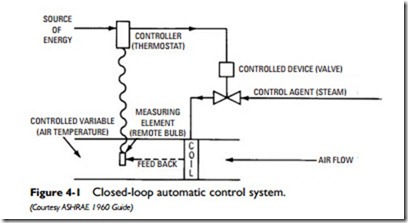This chapter, and the two that immediately follow it, describe the principal components of the automatic control systems used in heating, ventilating, and air conditioning. The index should also be checked because additional information about automatic controls has been included in other chapters.
Automatic Control Systems
An automatic control system consists primarily of the following two basic components:
• Controller
• Controlled device
A controller is any device that can detect changes in temperature, humidity, or pressure and respond to these changes by activating a controlled device.
A controlled device may be a valve or a damper, or a motor that drives either of the two. It may also be a pump, fan, electric relay, or any other device used to regulate the flow of air, steam, water, gas, or oil.
Automatic control systems can be classified as either closed loop or open loop. A closed-loop system (see Figure 4-1) is the more common type and involves the following stages in the control sequence:
1. The controller measures a change in a variable condition (e.g., temperature) and actuates the controlled device.
2. The controlled device compensates for the change in the variable condition by regulating the flow rate of the medium (e.g., water, air, steam) carried in the system.
3. The result of the action of the controlled device is measured, and this information is fed back to the controller completing (i.e., closing) the loop.
An example of an open-loop system is one using an outdoor thermostat. It is characterized by having no means of feedback. In other words, room temperature has no effect on the operation of the controller.
